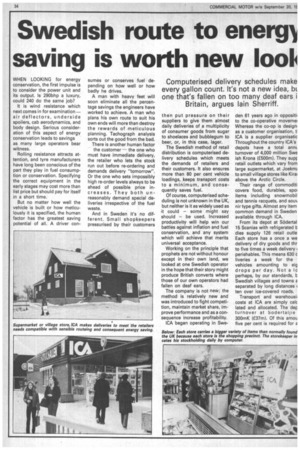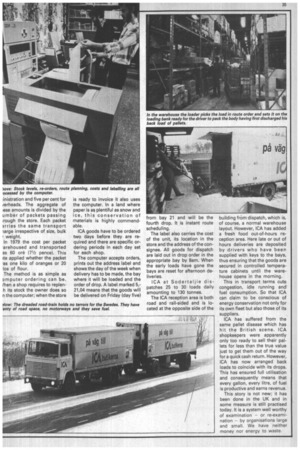Swedish route to energi saving is worth new boll
Page 36

Page 37

If you've noticed an error in this article please click here to report it so we can fix it.
WHEN LOOKING for energy conservation, the first impulse is to consider the power unit and its output. Is 290bhp a luxury, could 240 do the same job?
It is wind resistance which next comes in for examination — air deflectors, underside spoilers, cab aerodynamics, and body design. Serious consideration of this aspect of energy conservation leads to savings as many large operators bear witness.
Rolling resistance attracts attention, and tyre manufacturers have long been conscious of the part they play in fuel consumption or conservation. Specifying the correct equipment in the early stages may cost more than list price but should pay for itself in a short time.
But no matter how well the vehicle is built or how meticulously it is specified, the human factor has the greatest saving potential of all. A driver con sumes or conserves fuel depending on how well or how badly he drives.
A man with heavy feet will soon eliminate all the percentage savings the engineers have worked to achieve. A man who plans his own route to suit his own ends will more than destroy the rewards of meticulous planning. Tachograph analysis sorts out the good from the bad.
There is another human factor the customer – the one who must have immediate delivery, the retailer who lets the stock run out before re-ordering and demands delivery "tomorrow". Or the one who sets impossibly high re-order levels always to be ahead of possible price increases. They both unreasonably demand special deliveries irrespective of the fuel waste.
And in Sweden it's no different. Small shopkeepers pressurised by their customers then put pressure on their suppliers to give them almost daily deliveries of a multiplicity of consumer goods from sugar to shoelaces and bubblegum to beer, or, in this case, lager.
The Swedish method of retail distribution is computerised delivery schedules which meets the demands of retailers and their customers. It also ensures more than 80 per cent vehicle loadings, keeps transport costs to a minimum, and consequently saves fuel.
Of course, computerised scheduling is not unknown in the UK, but neither is it as widely used as it could – some might say should – be used. Increased productivity will help win our battles against inflation and fuel conservation, and any system which will achieve that merits universal acceptance.
Working on the principle that prophets are not without honour except in their own land, we looked at one Swedish operator in the hope that their story might produce British converts where those of our own operators had fallen on deaf ears.
The company is not new; the method is relatively new and was introduced to fight competition, maintain market share, improve performance and as a consequence increase profitability.
ICA began operating in Swe den 61 years ago in oppositii to the co-operative movemei Whereas the co-op is design' as a customer organisation, ti ICA is a supplier organisatic Throughout the country ICA's depots have a total anne turnover of 4,000 million Swe ish Krona (£500m). They supp retail outlets which vary from large supermarket, at JoekmE to small village stores like Kirai above the Arctic Circle.
Their range of comrnoditi covers food, durables, spot items including snowmobil and tennis racquets, and souv nir type gifts. Almost any item common demand in Sweden available through ICA.
From its depot at SOdertal 15 Scanias with refrigerated b dies supply 126 retail outle Each store has a once a we delivery of dry goods and thr to five times a week delivery I perishables. This means 630 c liveries a week for the vehicles amounting to eig drops per day. Not a la perhaps, by our standards, b Swedish villages and towns a separated by long distances c ten over ice-covered roads.
Transport and warehousii costs at ICA are simply calc lated and allocated. The dep turnover at Sodertaliie 300mK (E37m). Of this amou five per cent is required for a
inistration and five per cent for ierheads. The aggregate of ese amounts is divided by the umber of packets passing 'rough the store. Each packet 3 rries the same transport large irrespective of size, bulk
weight.
In 1979 the cost per packet arehoused and transported as 60 ore (71/2 pence). This rte applied whether the packet as one kilo of oranges or 20 los of flour.
The method is as simple as bmputer ordering can be. then a shop requires to replenh its stock the owner does so n the computer; when the store is ready to invoice it also uses the computer. In a land where paper is as plentiful as snow and ice, this conservation of materials is highly commendable.
ICA goods have to be ordered two days before they are required and there are specific ordering periods in each day set for each shop.
The computer accepts orders, prints out the address label and shows the day of the week when delivery has to be made, the bay where it will be loaded and the order of drop. A label marked 5,21,04 means that the goods will be delivered on Friday (day five) from bay 21 and will be the fourth drop. It is instant route scheduling.
The label also carries the cost of the unit, its location in the store and the address of the consignee. All goods for dispatch are laid out in drop order in the appropriate bay by Sam. When the early loads have gone the bays are reset for afternoon deliveries.
ICA at Sodertaljie dispatches 25 to 30 loads daily amounting to 130 tonnes.
The ICA reception area is both road and rail-sided and is located at the opposite side of the building from dispatch, which is, of course, a normal warehouse layout. However, ICA has added a fresh food out-of-hours reception area. Here late or out of hours deliveries are deposited by drivers who have been supplied with keys to the bays, thus ensuring that the goods are secured in controlled temperature cabinets until the warehouse opens in the morning.
This in transport terms cuts congestion, idle running and fuel consumption. So that ICA can claim to be conscious of energy conservation not only for its own fleet but also those of its suppliers.
ICA has suffered from the same pallet disease which has hit the British scene. ICA shopkeepers were apparently only too ready to sell their pallets for less than the true value just to get them out of the way for a quick cash return. However, ICA has now arranged back loads to coincide with its drops. This has ensured full utilisation and consequently means that every gallon, every litre, of fuel is productive and earns revenue.
This story is not new; it has been done in the UK and in some measure is still practised today. It is a system well worthy of examination or re-examination by organisations large and small. We have neither money nor energy to waste.






























































































































